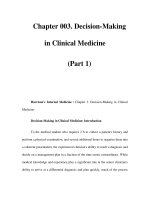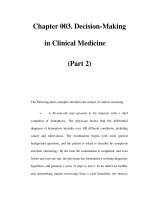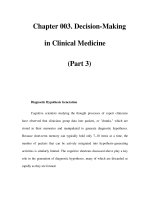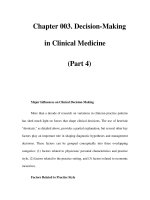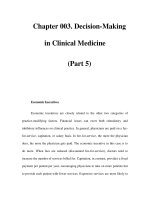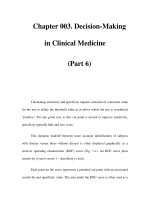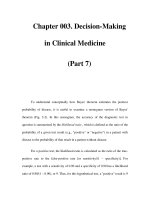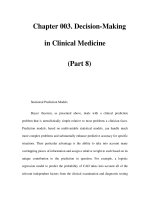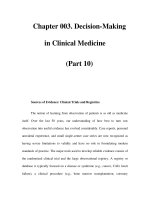Chapter 003. Decision-Making in Clinical Medicine (Part 1) doc
Bạn đang xem bản rút gọn của tài liệu. Xem và tải ngay bản đầy đủ của tài liệu tại đây (11.95 KB, 4 trang )
Chapter 003. Decision-Making
in Clinical Medicine
(Part 1)
Harrison's Internal Medicine > Chapter 3. Decision-Making in Clinical
Medicine
Decision-Making in Clinical Medicine: Introduction
To the medical student who requires 2 h to collect a patient's history and
perform a physical examination, and several additional hours to organize them into
a coherent presentation, the experienced clinician's ability to reach a diagnosis and
decide on a management plan in a fraction of the time seems extraordinary. While
medical knowledge and experience play a significant role in the senior clinician's
ability to arrive at a differential diagnosis and plan quickly, much of the process
involves skill in clinical decision-making. The first goal of this chapter is to
provide an introduction to the study of clinical reasoning.
Equally bewildering to the student are the proper use of diagnostic tests and
the integration of the results into the clinical assessment. The novice medical
practitioner typically uses a "shotgun" approach to testing, hoping to hit a target
without knowing exactly what that target is. The expert, on the other hand, usually
has a specific target in mind and efficiently adjusts the testing strategy to it. The
second goal of this chapter is to review briefly some of the crucial basic statistical
concepts that govern the proper interpretation and use of diagnostic tests.
Quantitative tools available to assist in clinical decision-making will also be
discussed.
Evidence-based medicine is the term used to describe the integration of the
best available research evidence with clinical judgment and experience in the care
of patients. The third goal of this chapter is to provide a brief overview of some of
the tools of evidence-based medicine.
Clinical Decision-Making
Clinical Reasoning
The most important clinical actions are not procedures or prescriptions but
the judgments from which all other aspects of clinical medicine flow. In the
modern era of large randomized trials and evidence-based medicine, it is easy to
overlook the importance of this elusive mental activity and focus instead on the
algorithmic practice guidelines constructed to improve care. One reason for this
apparent neglect is that much more research has been done on how doctors should
make decisions (e.g., using a Bayesian model, discussed below) than on how they
actually do. Thus, much of what we know about clinical reasoning comes from
empirical studies of nonmedical problem-solving behavior.
Despite the great technological advances of medicine over the last century,
uncertainty still plays a pivotal role in all aspects of medical decision-making. We
may know that a patient does not have long to live, but we cannot be certain how
long. We may prescribe a potent new receptor blocker to reverse the course of a
patient's illness, but we cannot be certain that the therapy will achieve the desired
result and that result alone. Uncertainty in medical outcomes creates the need for
probabilities and other mathematical/statistical tools to help guide decision-
making. (These tools are reviewed later in the chapter.)
Uncertainty is compounded by the information overload that characterizes
modern medicine. Today's experienced clinician needs close to 2 million pieces of
information to practice medicine. Doctors subscribe to an average of seven
journals, representing over 2500 new articles each year. Computers offer the
obvious solution both for management of information and for better quantitation
and management of the daily uncertainties of medical care. While the technology
to computerize medical practice is available, many practical problems remain to be
solved before patient information can be standardized and integrated with medical
evidence on a single electronic platform.

